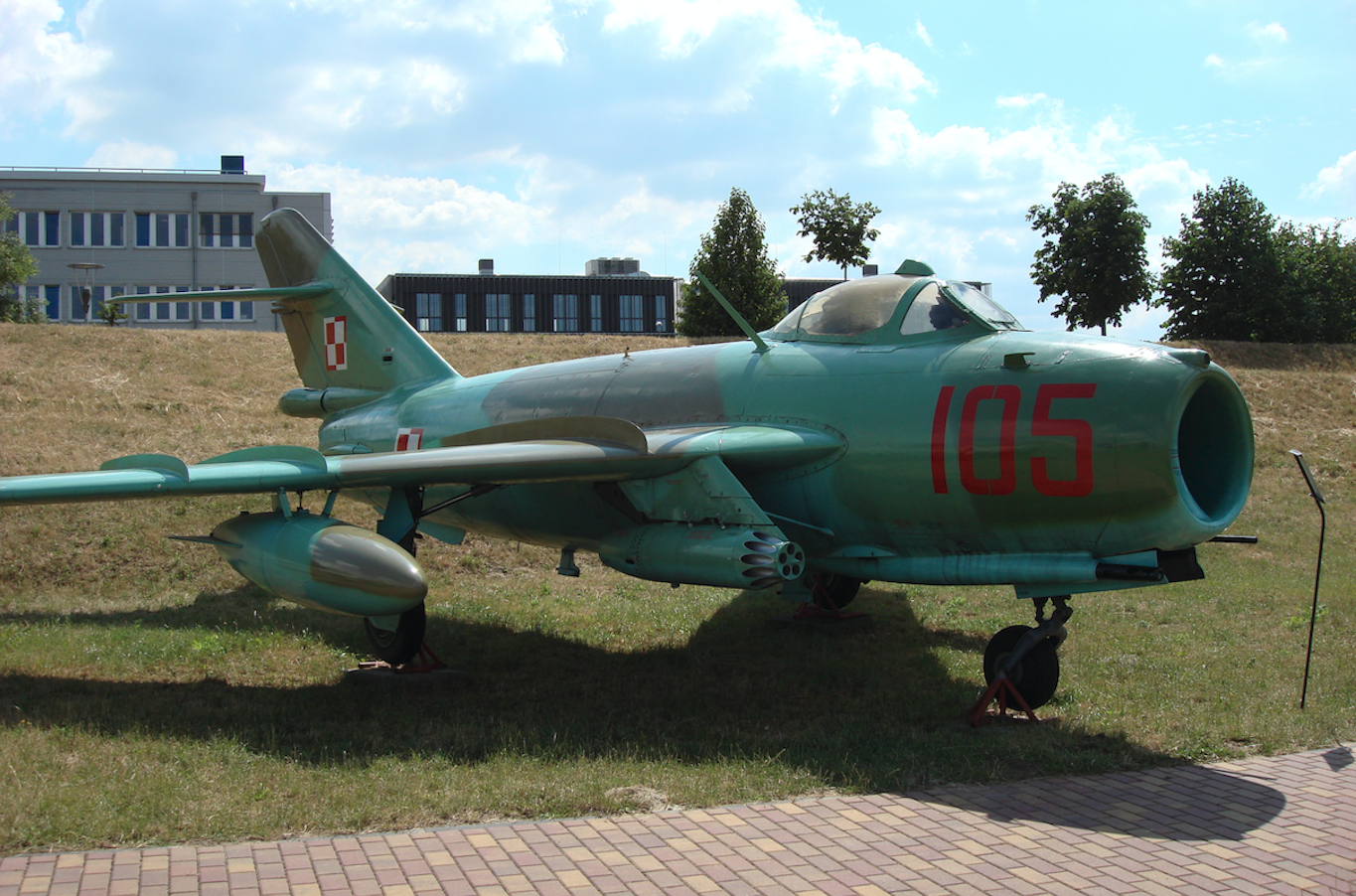Kraków 1-05-2007
167b Section 1959.07.02.
WSK Mielec ( LZR ) Lim-5 M, Lim-6 bis, Lim-6 M ( MR ).
Poland
Fighter-attack and direct support reconnaissance aircraft. History of Lim-5 M. 1959
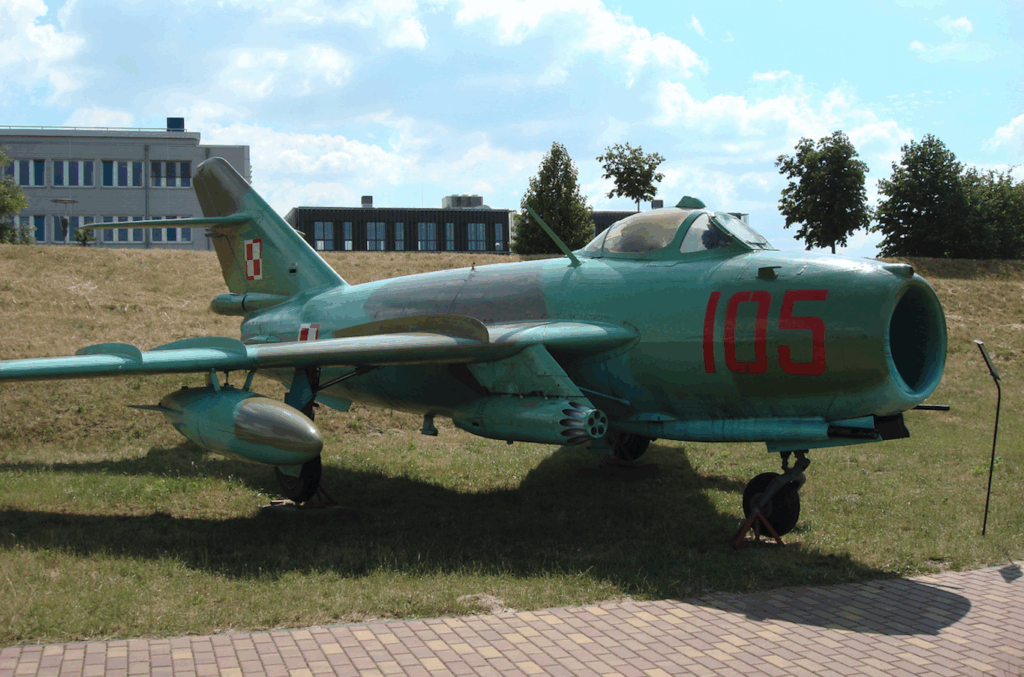
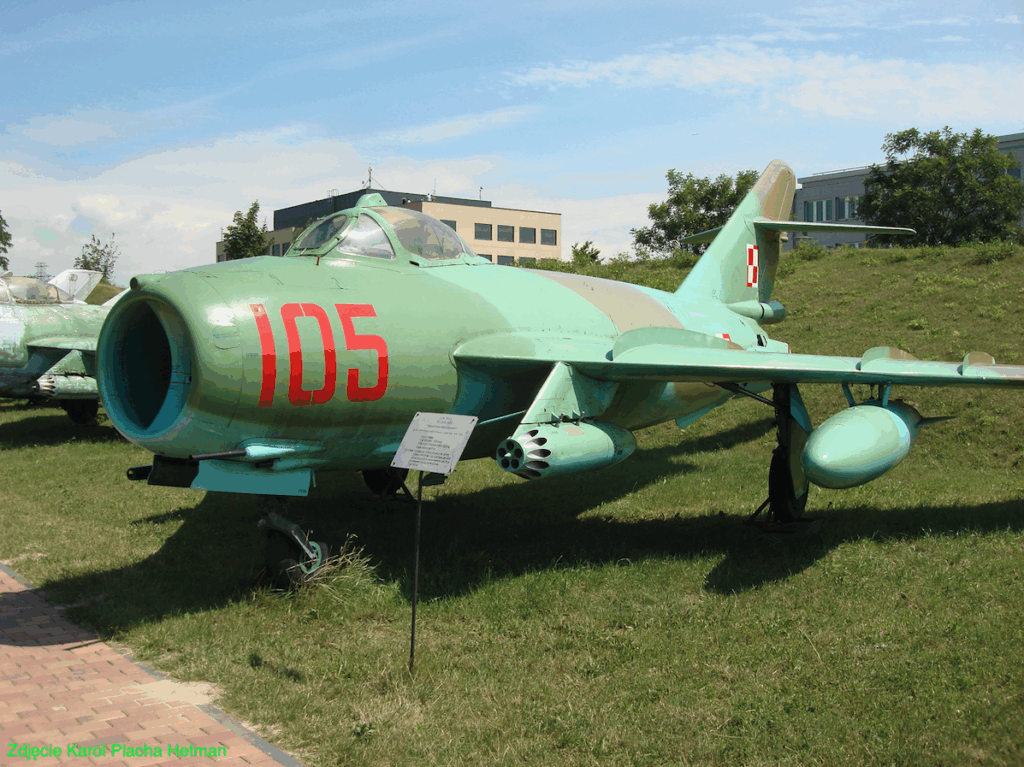
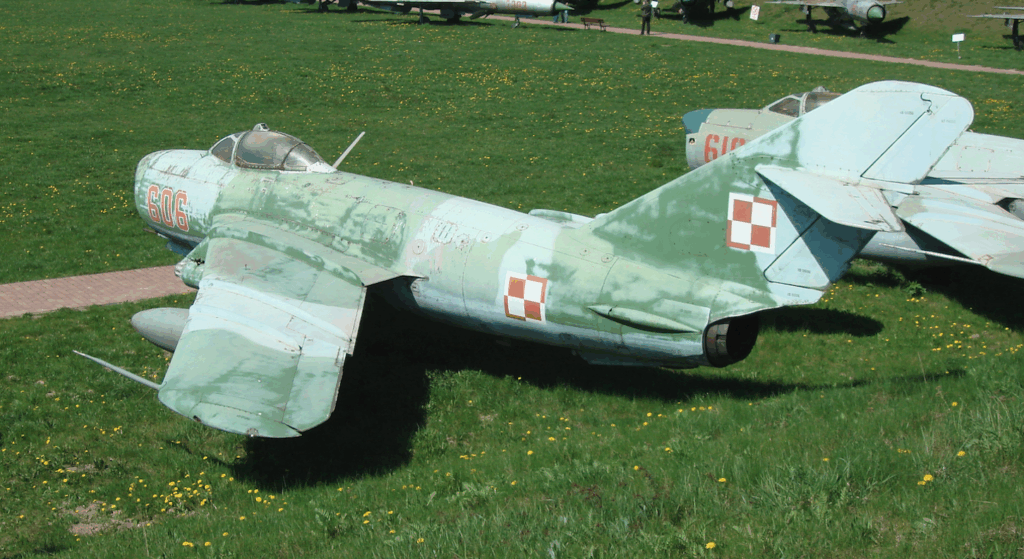
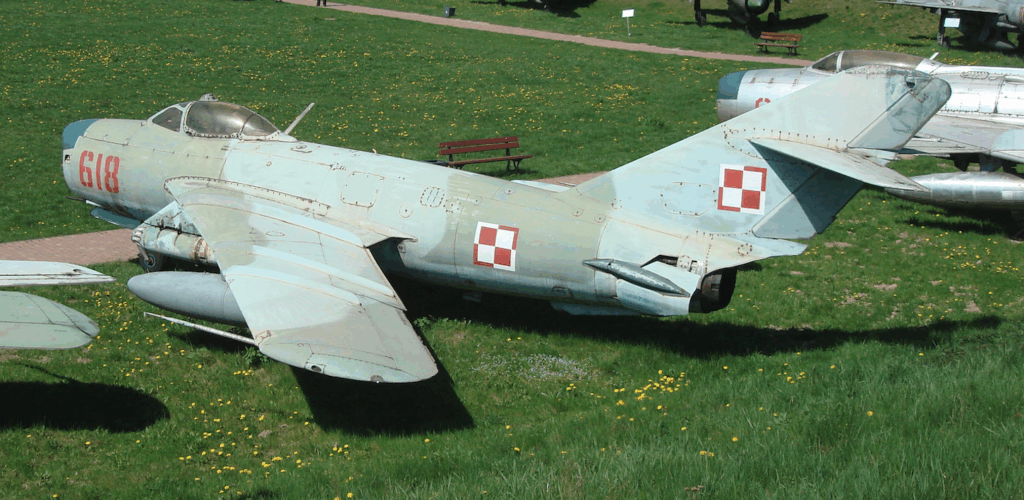
History Lim-5 M. 1959
The development of nuclear weapons changed military doctrines. The role of piston attack aircraft was decreasing. There was no successor to the Il-10 aircraft in Poland, and the “brotherly country” (CCCP) did not conduct work on such an aircraft type. In Polish conditions, new concepts of using fighter aviation appeared. In 1960, fighter-attack aviation was established.
At the end of 1957, it was decided to modify the Lim-5 aircraft. The stimulus for the modification was familiarization with the requirements for a modern fighter-attack aircraft developed by the NATO headquarters in 1954. After a detailed analysis, it turned out that Lim-5 was close to meeting these requirements. The modification of the CF aircraft (Lim-5) was codenamed CM. At the beginning of 1958, in Mielec, under the supervision of engineer Feliks Borodzik, work began on the Lim-5 M model.
At the beginning, the directions of changes were determined: Adaptation for operation from field airports, by using doubled main landing gear wheels. Shortening the take-off run by using a braking parachute. Shortening the take-off run by using rocket launch accelerators. Analyzing the possibility of using more effective airfoil mechanization. Increasing the radius of action by adding a second pair of additional tanks. Using rocket armament. Due to the increase in empty weight, increase the engine thrust. Analyzing the possibility of improving visibility from the cabin. Even moving the cabin forward and using side air intakes was considered.
Due to the fact that the Lim-5 aircraft was a licensed version of the Soviet MiG-17 aircraft, and also due to the political realities prevailing at the time, on September 27, 1958, two designers from the WSK Mielec office went to Moscow for consultations. There, as a result of several meetings, including those with the participation of Artem Mikoyan himself, the planned modification work was analyzed. In order to speed up the modernization, changes were introduced gradually. The military delivered a 1C 10-30 aircraft for reconstruction, and a few months later another 1C 16-01 aircraft.
At the beginning of 1958, the CM-I aircraft was created. Rocket accelerators with a thrust of 2 x 9.81 kN appeared on the sides of the rear part of the fuselage. A PT-19 braking ribbon parachute was mounted in the place where the under-fuselage comb is (other sources give the symbol SH-19). The prototype with the serial number CM-10-30 was flown on July 2, 1959. After completing the first stage tests, without approval and without waiting for the end of the flights, serial production was prepared. The take-off weight of the CM-I aircraft in the fighter configuration was 5,697 kg, and in the attack configuration 5,762 kg. The maximum speed was 1,080 km/h, and the ceiling was 14,100 m.
The CM-II project was created a little later than the CM-I (CM 10-30). This aircraft introduced doubled main landing gear wheels and fairing tanks, near the fuselage in front of the wing. The fairing tanks held 560 liters of fuel. The tanks were initially made of metal, and later of composite. At this stage, the CM-II aircraft was named Lim-5 M.
On December 28, 1959, both prototypes, officially referred to as the Lim-5 M aircraft, were transferred to a field airport and tested there. The aim of these tests was to determine whether the intended tactical and technical effects had been achieved. The results were positive. Doubled wheels ensured that the fighter was completely dependent on concrete runways (RWY). Even cracks during landing of one of the tires turned out to be harmless. The parachute shortened the take-off run by 250 m. The take-off run was slightly worse. The take-off run was extended by 40%, which was a result of changes in the aerodynamics of the wing. However, this was not taken into consideration, as the plan was to assemble launch rockets, which were ultimately not tested. These tests determined the decision to send the machine into production.
The data of the Lim-5 M aircraft were impressive. The take-off run on the grass was 710-770 m, and with launch rockets 350-370 m (estimated data). The take-off run was 1,140 m, and with a parachute 670 m. The armament included tubular launchers for Mars missiles; 2 x 8 x S-5. It was also possible to hang launchers for 16 or 24 rockets. The aircraft could have 2 x 3 heavy 132 mm caliber NMRs suspended by garlands. Of course, there was a possibility of various combinations of weapons. The pilots called the aircraft a collar or a scarf, because of the fairing-tanks. On November 30, 1960, the first serial Lim-5 M was produced, number 1F 01-01. (After years, this aircraft was rebuilt into Lim-6 bis.) Production lasted until May 10, 1961, and ended with the construction of 60 units, in three production series. The last aircraft was 1F 03-30. Despite some reservations about the aircraft, the decision was made to accept it into service, which was officially made by Order of the Ministry of National Defense No. 035/MON issued on July 5, 1961.
Application of Lim-5 M. 1961
Lim-5 M aircraft were transferred to the air force from December 1960 and were not very well-known. The aircraft caused great problems for its users. It turned out that the aircraft was difficult to fly. Its performance was much worse than the standard Lim-5. Flights were performed with significant limitations. The command assured the pilots that they would soon receive a new, improved type of attack aircraft. This did not happen until 1963. By that time, the equipment situation of the Operational Aviation (which was established in 1962, after the separation of the WL and OPL OK) was looking increasingly worse, there were even plans for an emergency purchase of 70 used Soviet MiG-17s. However, this did not happen.
Of the 60 Lim-5 M aircraft built in the period 1960 – 1961, they were delivered to the following combat units; 5th PLMSZ, 6th PLMSZ, 30th PLMSZ in Siemirowice and 48th PLMSZ. In 1963, the army had 44 Lim-5 M aircraft, respectively (18 units in the 5th PLMSZ, 14 units in the 6th PLMSZ, 16 units in the 30th PLMSZ and 12 units in the 48th PLMSZ).
Lim-5 M aircraft were delivered to Siemirowice, among others. In 1960, the 30th PLSZ (Attack Aviation Regiment) was stationed there, which changed its name to the 30th PLMSZ (Fighter-Attack Aviation Regiment) and adopted Lim-5 M aircraft. In 1963, the Regiment received TS-8 Bies training aircraft, and in 1964, Lim-6 bis aircraft, as we wrote below. In 1967, the 30th PLMSZ changed its name to the 7th PLMSZ.
History of the Lim-6.
The production of Lim-5 M aircraft did not mean the end of further modernization work. This was related to the CM-II project. The basic subject of this project was the blowing of compressed air onto the wing flaps. The aim was to achieve greater flap efficiency. The analysis showed that for the system to be fully effective, a plate-type horizontal tail should be used. However, such a tail was never built.
The work was carried out on the already familiar CM 10-30 model. The first tests of flaps with blowing were encouraging. The specific solution was tested from January 1961. The aircraft received the designation Lim-5 M-II. The engine adapted for blowing was designated Lis-5 M. The air for blowing was led from the engine through a pipe placed inside the wing and equipped with numerous nozzles. However, over time, problems arose. On January 7, 1961, the aircraft experienced its first pumping. It was not until July 1961 that the problem was successfully solved by installing non-return valves on the system. After state tests, on March 29, 1962, further tests with flap blowing were discontinued due to too small benefits and too much operational difficulty.
In 1960, the army additionally provided the aircraft 1C 19-04 for testing.
The fully completed CM 16-01 was approved as the CM-II program model and was given the designation Lim-5 M-II.
Immediately after the end of production of the Lim-5 M aircraft, in May 1961, before the full tests of the Lim-5 M-II aircraft (CM 16-01), a series of 40 aircraft were built, which were finally given the designation Lim-6. The engines changed their designation from Lis-5 M to Lis-6. The aircraft bore numbers from 1J 04-01 to 1J 04-40. It should be recalled that the CM 16-01 aircraft was rebuilt many times.
In addition to the installation of a blower on the flaps and a parachute placed at the base of the empennage, the Lim-6 received many other minor changes. For example, additional side cooling of the engine, which was to be a prelude to the feasibility of developing side air intakes. However, the Lim-6 aircraft was never taken over by the military in this form. The aircraft were later rebuilt. There were various other modifications of the Lim-5 M aircraft, which were not finalized. Among them, the aircraft with containers on the ends of the wings, which housed cameras of various types. A system for shortening the take-off run using two parachutes was also tested. Unfortunately, one parachute interfered with the opening of the canopy of the other.
Lim-6 history from 1962
Some of the built Lim-6 aircraft, not taken over by the army, were used for further tests. These included; 1J 04-02, -03, -04, -05.
Information from combat units on the operation of Lim-5 M aircraft and conducted research forced changes. On April 24, 1962, a meeting of the Lim-6 aircraft commission was held. Attention was drawn to the worsened handling with fairing-tanks and low efficiency of the flap blow. It was postulated to abandon these solutions. First, fairing-tanks were eliminated. Aircraft with fairing-tanks had a thicker wing. In flight, it had greater resistance and increased fuel consumption. Additionally, as the fuel in the tanks was depleted, the center of gravity shifted. The main goal – increasing the range was not so significant.
The landing gear with double wheels lasted longer. However, they required fairings, which worsened the flight characteristics. Tests showed vibrations and oscillations of the aircraft in flight. In addition, the importance of using ground airports was decreasing, so it was decided to abandon double wheels. Nevertheless, until the end of the aircraft’s service life, there was always a possibility of using this option.
As mentioned above, the flap blower was also abandoned. However, additional booms-nodes for armament appeared on the aircraft. On June 19, 1962, tests of the 1C 19-04 aircraft began. They concerned various variants of armament. The tests were completed on August 6, 1962, after 63 flights. The pilot was Z. Słonowski. Good flight characteristics were found, especially with the Mars-2 armament on the inner nodes.
As we remember, the aircraft could be equipped with rocket accelerators. In the second half of 1962, it was planned to equip the aircraft with accelerators with a higher thrust, 2 x 11.77 kN. Ultimately, however, due to the smaller increase in the aircraft’s empty weight, the accelerators were abandoned.
On June 25, 1962, the Ministry of National Defense approved the assumption of the CMR program, i.e. the attack and reconnaissance version. As mentioned above, tests of various reconnaissance pods mounted under the wings ended in failure, so ultimately the cameras mounted only under the fuselage were left. This solution was tested in the period from June to August 1962. On the sidelines, we will mention that the first Lim-5 aircraft equipped with the AFA-39 camera was the 1C 13-18, and the work was carried out in 1959.
The first weapons tests were carried out on August 28, 1962, when the Lim-6 bis CM 10-30 prototype used FAB-250, OFAB-100 bombs and S-5 missiles.
On September 13, 1962, binding decisions were made. It was decided to reconstruct the produced Lim-6 aircraft to the Lim-6 bis standard with the option of building 70 new aircraft by the end of 1963. For 1964, it was planned to build an additional 56 aircraft in the typical reconnaissance version of the Lim-6 R. The latter plan was not implemented, as production of the TS-11 aircraft was undertaken. It was therefore decided that the Lim-6 bis series V and VI aircraft would be equipped with the AFA-39 camera, placed under the fuselage. The name Lim-6 bis R or Lim-6 R was even proposed, but this idea was abandoned.
On November 7, 1962, the final version of the attack aircraft, called Lim-6 bis, was approved. On December 5, 1962, factory tests began, which lasted until April 16, 1963. At the beginning of 1963, the reconstruction of the Lim-6 aircraft to the Lim-6 bis variant began. These were the aircraft previously produced but not delivered to the military. The first aircraft No. 1J 04-07 left WSK Mielec on March 23, 1963. Another 70 aircraft were built from scratch, in two series, V and VI. The last one was No. 1J 06-40, built on February 25, 1964.
All Lim-5 M aircraft were rebuilt to the Lim-6 bis version. This work was carried out at LZR-4 (aviation repair plants). Later, No. 1J 16-01, which was the experimental CM 16-01 (June 15, 1965) and No. 1J 04-41 (September 30, 1969) were also transferred to military units.
From April 15, 1964 to June 27, 1964, state tests of the aircraft were carried out. Several minor defects were noted and their removal was ordered. The Lim-6 bis aircraft was officially accepted into service on September 14, 1964, when the protocol from state tests was approved.
Use of the Lim-6. 1963
On 28 March 1963, 53rd PLMSZ (fighter-attack aviation regiment) received the first 10 Lim-6 bis aircraft: 1J 04-05, -07, -08, -09, -11, -12, -13, -14, -15, -17. A dozen or so days later, on 11 April 1963, another regiment, 51st PLMSZ in Piła also received 10 aircraft: 1J 04-02, -03, -04, -10, -16, -18, -19, -20, -21, -22. Thanks to this, the number of combat aircraft in Operational Aviation in April 1963 was: 60 Lim-5 M aircraft (18 units in the 5th PLMSZ, 14 units in the 6th PLMSZ, 16 units in the 30th PLMSZ and 12 units in the 48th PLMSZ) and 20 Lim-6 bis aircraft (10 units each in the aforementioned 51st and 53rd PLMSZ). On 29 April 1963, the 53rd PLMSZ received 1J 04-25 and -27, and the 51st PLMSZ received another 5 Lim-6 bis aircraft: 1J 04-23, -24, -26, -28, -32. On May 25, 1963, the 53rd PLMSZ received: 1J 04-29, -30, -31, -35, -36, -38, -40, while the 51st PLMSZ from Piła received: 1J 04-32, -33, -34, -37, -39. On June 25, 1963, the 53rd PLMSZ received the 1J 04-06 aircraft. The first exercises of Lim-6 bis aircraft, with the support of the land forces, were carried out in April 1963, using Lim-6 bis aircraft from the 53rd PLMSZ at the training ground in Drawsko Pomorskie. Soon, on June 12, 1963, during a flight by 2nd Lt. pilot Cieśluk, the first Lim-6 bis was lost due to a failure of the engine control system. The pilot ejected.
On June 18, 1963, the first newly produced Lim-6 bis from series 5 reached combat units. On that day, the 53rd PLMSZ received: 1J 05-01, -02, -03, -05. Another aircraft with the number No. 1J 05-04 was transferred to the Air Force Institute of Technology ( ITWL ).
On June 21, 1963, the first fatal accident occurred, Lim-6 bis from the 53rd PLMSZ piloted by Capt. Pilot Kozak. The aircraft crashed near Mirosławiec. On September 11, 1963, another disaster with a fatality in the 53rd Regiment, when 2nd Lt. Pilot Błahut crashed into a forest during bombing flights at the Nadarzyce training ground.
On 14 November 1963, transfer of new aircraft took place to up to four air regiments: 53rd PLMSZ received: 1J 05-06, -07, -08, -09, -10, -16, -17, 51st PLMSZ received: 1J 05-11, -12, -13, -14, -15, -18, -19, 20, 6th PLMSZ received: 1J 05-21, -22, -23, -24, -25, -27, 5th PLMSZ received: 1J 05-26, -28, -29, -30. This ended production of the 5th series.
The next machines were already of the 6th series and arrived already in the new 1964. And so, on January 6, 1964, the first three Lim-6 bis aircraft were received by the 21st PLRT (tactical reconnaissance aviation regiment) from Sochaczew: 1J 06-01, -02, -04. On January 15, 1964, one aircraft received the command key of the 16th Fighter-Attack Aviation Division, it was No. 1J 06-12. A day later, that is on January 16, 1964, 7 aircraft reached the 21st PLRT: 1J 06-05, -06, -07, -08, -09, -11, -14, the next ones to the 53rd PLMSZ: 1J 06-10 and -13. On 25 January 1964, the 30th PLMSZ from Siemirowice received: 1J 06-03, -15 to -30, and on 2 March 1964, the next ones: 1J 06-31, -32, -33, -34, 39, -40. The last four aircraft built as part of the 6th production series were received in two installments by the 21st PLRT, on 6 March 1964 (1J 06-37, -38) and 13 March 1964 (1J 06-35, -36). After that time, the army received three more examples rebuilt from aircraft used in work on the Lim-6 family. This was transferred to the 21st PLRT on 8 June 1965, No. 1J 04-01. On June 15, 1965, CM 16-01 / nb 1601 was delivered to the 53rd PLMSZ. The last one to be handed over to the army on September 30, 1969, was copy No. 1J 04-41, which until then had been CM 10-30.
In September 1964, for the first time in history, a landing was made on a motorway. This was done by pilots from regiments flying Lim-6 bis. Since then, Lim-6 bis aircraft have been a part of the history of Polish military aviation for a very long time, constituting the backbone of operational aviation.
At the beginning of the 70s of the 20th century, Lim-6 bis aircraft were in service with: 6th PLMSZ in Piła, 8th PLMSZ in Mirosławiec, 7th PLMSZ in Siemirowice, 45th PLMSZ in Babimost.
In 1982, the existing Attack-Reconnaissance Aviation Divisions were reformed into Fighter-Bomber Aviation Divisions, and the regiments were thus reclassified as fighter-bomber units, with the exception of the 7th Bomber-Reconnaissance Aviation Regiment.
The last major exercise in which the Lim-6 bis was used was the Warsaw Pact exercise “Przyjaźń 85”. This was already the slow end of the career of this type of aircraft in fighter-bomber aviation, because the Su-22 aircraft was coming. In 1984, the 6th PLMB got rid of its Lim-6 bis. In 1985, the 8th PLMSZ from Mirosławiec, exchanged its Lim-6 bis for Lim-6 M aircraft from the 40th PLMB. In 1986, the 21st PLMB from Powidz was disbanded. In mid-1988, the last Lim-6 bis were withdrawn from the 30th Navy Regiment. Some of the aircraft were sent to the base in Mierzęcice, and most to the last regiment that had Lim-6 bis aircraft, the 45th PLMB in Babimost, which in August 1988 became a training and combat unit. After the regiment in Babimost was disbanded in 1992, Lim-6 bis aircraft disappeared from the Polish sky.
Lim-6 M / MR. 1971.
As time passed, the Lim-5 P interceptors (with radar sights) used by the army ceased to fulfill their role. Since they still had a long service life of the airframes, it was decided to rebuild them into fighter-attack versions. The SR was removed from the aircraft. To maintain balance, the battery was moved forward and weight was added. An AFA-39 camera was installed. Additional armament nodes were added. A braking parachute was not installed.
The work was carried out at LZR-2 in Bydgoszcz. The aircraft was initially designated Lim-5 P bis, but eventually the name Lim-6 M was adopted. The designation Lim-6 MR is also used. The first aircraft so rebuilt in 1971 was No. 1D 06-02. In the period 1972-1978, about 60 Lim-5 P aircraft were rebuilt to the Lim-6 M standard. The Polish modernization of Lim-5 also became the subject of export to the GDR. As part of the aircraft renovations, additional nodes were built for the Mars-2 launchers, a total of 30 sets, or 60 nodes.
Attempt to evaluate the Lim-5, Lim-6 aircraft.
The Lim-5 aircraft as fighters quickly became outdated. The era of supersonic aircraft was fast approaching. Nevertheless, the development of the fighter-attack version turned out to be a successful operation. The Lim-6 bis became a fixture in attack aviation for many years. In 1969, tests were carried out on several types of aircraft in direct support missions. Of the MiG-21, Su-7 and Lim-6 bis aircraft, the highest rating was given to the latter. It is impossible to overestimate the role that this particular aircraft played in our military aviation. Many pilots remember this aircraft with great sentiment.
Comparison of versions from the CCCP and Poland.
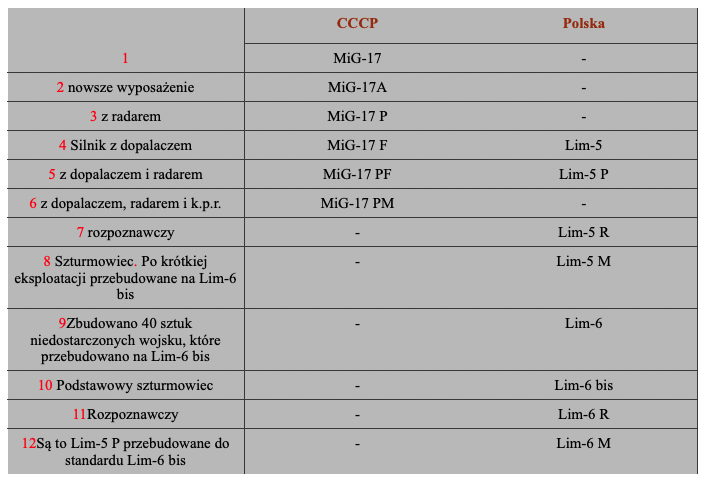
Written by Karol Placha Hetman

